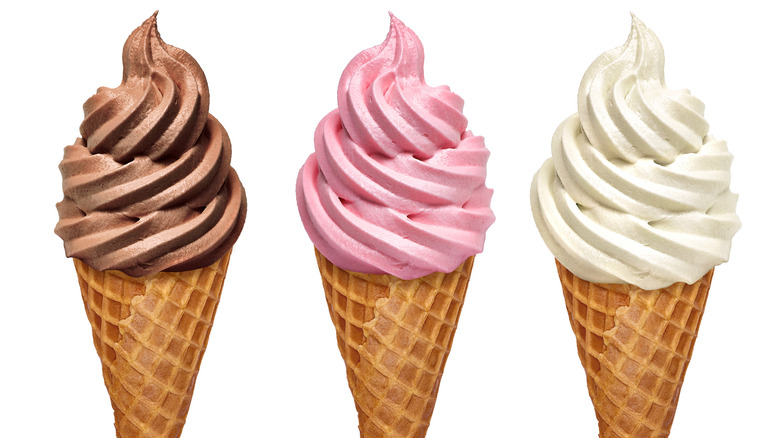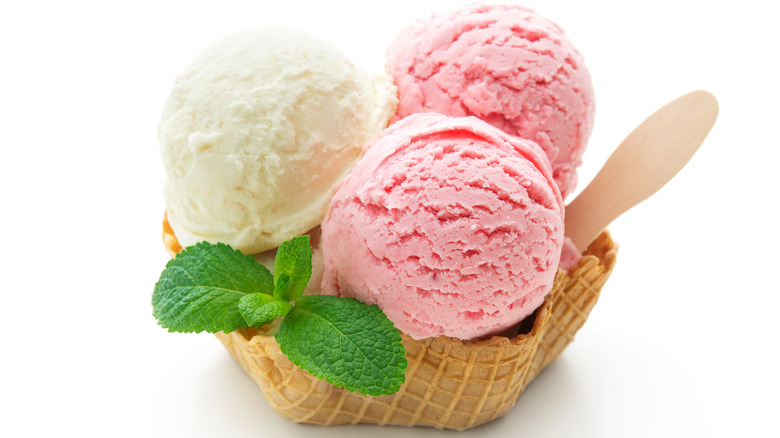What Makes Frozen Custard Different From Ice Cream
One of the coolest things about desserts is how perfectly they seem to reflect the changing of the seasons, to the point where sometimes it appears as if the temperature of the dessert has to be in direct contrast to the temperatures outside. That's certainly the case during the summertime. As the days get warmer, the treats get cooler, and everyone's favorite seasonal snack or preferred after dinner nosh seems to begin with words like ice or frozen.
Like ice cream or frozen custard, for instance. These two classic desserts and consummate summer satisfiers both boast long histories in the U.S. In fact, the country's love affair with ice cream dates all the way back to when George Washington was president, according to PBS. No one knows if the Founding Father visited the first ice cream parlor, which opened in New York in 1790 (although some would argue that this occurred between 1774 and 1776), but he did have a legendary sweet tooth, reputedly spending $200 on ice cream in that year alone.
Frozen custard's history, meanwhile, isn't quite so old or estimable, but it too entered the American mainstream by way of New York. As Gilles Frozen Custard notes, the first recorded examples were sold by the Kohr Brothers at Coney Island in 1919.
So what makes these two treats their own?
The ingredient that defines frozen custard
It's not just summertime and a shared historical geography that binds ice cream and frozen custard together. The two desserts actually share almost exactly the same ingredients. Well, with one exception. Ice cream and frozen custard are both whipped up with milk, cream, and sweetener, per Allrecipes, but only frozen custard also adds egg yolks.
As a matter of fact, egg yolk must be present in commercially sold frozen custard by law. According to regulations set forth by the U.S. Food and Drug Administration, both ice cream and frozen custard are each required to have at least 10% milkfat, while frozen custard must also have 1.4% egg yolk (although this percentage may be reduced to a minimum of 1.12% if other flavors are included).
Of course, these standards don't apply to frozen custards made in home kitchens, but egg yolks remain an essential and definitive ingredient, per Allrecipes, since they give frozen custard its trademark thicker texture.
Why ice cream is the king of summer desserts
Ice cream and frozen custard are both delightful, but there's no comparison when it comes to popularity. Ice cream is so popular its sales are a major contributor to the U.S. economy, accounting for over $13 billion dollars a year, and supporting over 28,000 jobs, per the International Dairy Foods Association.
What is it about ice cream that makes it so delicious that we never seem to stop craving it? There are a couple of compelling reasons. One, rather counterintuitively, is air. According to the American Chemical Society, the air churned into ice cream when it's made is known as overrun, and it can end up accounting for as much as half the iconic dessert's total volume. The addition of all this air changes the taste and texture of ice cream ... but in a good way. Sugar and fat, not surprisingly, also play a major part in ice cream's enduring appeal. As Bon Appétit notes, sugar gives ice cream structure, helping to form that oh-so-scoopable body. Fat, on the other hand, adds buttery mouthfeel and creamy texture.
Add it all up and you have one of summer's greatest pleasures. For variety's sake, though, add some frozen custard to the summertime menu, along with sorbet, frozen yogurt, popsicles, and eskimo pies.


